Swift & Son Antique Brass Wenham Binocular Challenge Polarizing Microscope
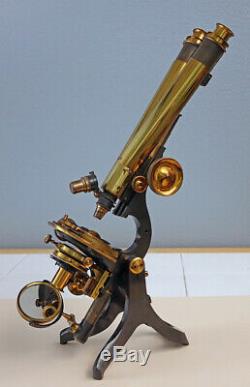

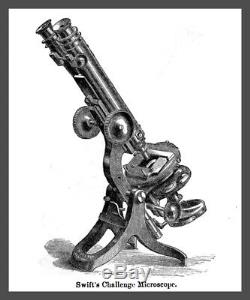
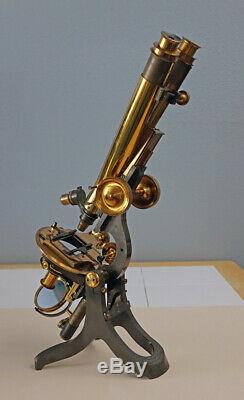

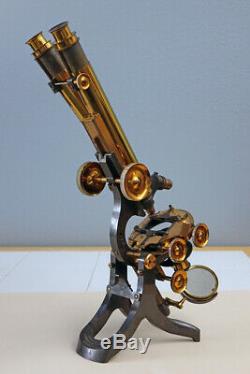
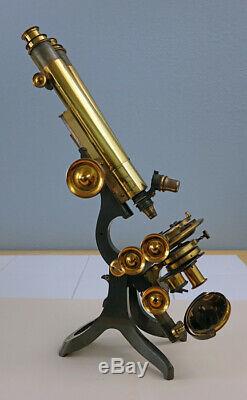
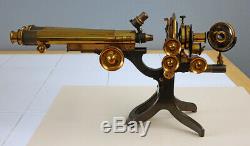
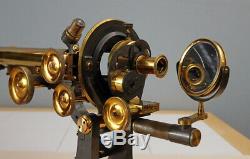
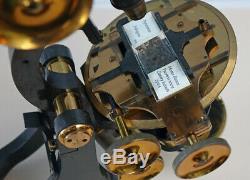

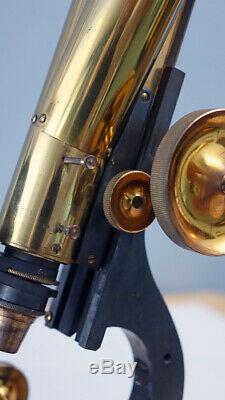

JAMES SWIFT & SON ANTIQUE BRASS WENHAM BINOCULAR CHALLENGE POLARIZING MICROSCOPE. JAMES SWIFT & SON ANTIQUE BRASS WENHAM BINOCULAR CHALLENGE POLARIZING MICROSCOPE CIRCA 1895. In addition, this binocular microscope includes polarizing features that enable qualitative investigations of thin mineral sections and other specimens under polarized light. This microscope is signed in block letters on the top rear of the English style foot, SWIFT & SON, 81 TOTTENHAM COURT RD. (See accompanying close-up image of this engraved signature). This instrument does not bear a typical serial number. Even when a serial number is present on Swift & Son instruments, accurately dating the microscope is problematic because, as Bracegirdle explains, Swift & Sons numbering policy seems to have been quite erratic and many of their stands lack a serial number. However, based on the overall design of this fine instrument, we can conservatively estimate its date of construction as circa 1895. Swift & Son first introduced this model microscope in circa 1880. Initially the instrument had a very simple circular stage, a simple substage and a typical spring-loaded objective nosepiece fine focus mechanism. Later, beginning in the early 1890s, this model was greatly improved with the addition of a very elaborate and well-engineered rotating stage with a compression type slide holder, a side-lever fine focus system and a centering objective nosepiece or dual rotating objective holder. A much more complex substage assembly was also added, replacing a simple rotating disc of apertures that was found on the earlier versions. It appears that these improvements were added gradually over time and not all at once. The instrument featured here also includes polarizing features, described in more detail below, that are not always found on all of the Swift Challenge microscope models. Accompanying this listing is an image of one of the latter versions of this model microscope as found in my personal library copy of the publication entitled, The Microscope And Its Revelations (Sixth Edition) by William B. Carpenter and published in London in 1881. Note the similarities and differences to the instrument featured here. The instrument featured here appears to be the final iteration of this model microscope as it evolved over the years since its first introduction and including polarizing features.
Many antique microscope collectors and avid microscopists who have had an opportunity to examine and use one of Swift & Sons Challenge Wenham binocular microscopes have generally agreed that this particular model instrument is surpassed by no other of its kind in its scientific ingenuity and the excellence of its workmanship. As you examine the accompanying images of this particular example of the Swift Challenge microscope, I believe that you will tend to agree with this assessment.
Dont miss this opportunity to add this outstanding antique brass microscope to your collection. In addition, if you should have a special interest in the evolution and design of polarizing petrographic microscopes, this instrument with its polarizing features will be of particular interest to you. This microscope is supported on a heavy, sturdy English style tripod or claw foot that has a black lacquered surface. The foot rises to a wide trunnion joint that supports the limb, and in turn, the stage and rest of the instrument.
The trunnion joint allows the instrument to be inclined at all angles from the vertical to the horizontal (See accompanying image that shows the microscope in the horizontal position). Mechanically affixed to the lower limb is a U shaped stage holder that also has a rectangular dovetail support rail extension at the bottom that is used to attach the dovetailed substage apparatus described below. In turn, mechanically attached to this stage holder assembly is a rotating round stage plate that features a 45 x 50 mm stage opening. Mounted on top of the rotating stage plate is the elaborate mechanical stage that has 25mm of vertical movement controlled by rack and pinion and 25mm of horizontal movement controlled by a fast-pitch screw system. Brass milled heads found on the right side of the mechanical stage are used to control its x-y movements. The entire stage assembly can be rotated. Mounted atop the mechanical stage are two sliding ledges, designed after the Zentmayer pattern, that are used to retain specimen slides. The substage has rack and pinion focusing. The entire apparatus is mounted on a dovetail assembly so it can be moved laterally to the left until it reaches a set stop or even removed entirely from the microscope by sliding it to the right and off of its support rail (See accompanying image that shows the substage assembly removed from the stand).The substage apparatus features a centering substage ring on the top that contains a built-in iris diaphragm. This ring can accommodate a standard Abbe condenser (not included). Mounted under the centering ring/condenser holder is a rotating disc assembly with four ports: An open port, a port equipped with a dark stop that can be moved in or out of the light path, a threaded port for a Nicol prism polarizer (included), and a brass slip ring that can accommodate an alternative achromatic condenser (not included) or other appropriate attachments.
The port for the Nicol prisim polarizer also has an associated additional rotating ring that has 4 ports: One open port and three threaded ports for filters or quartz, mica and selenite plates used in conjunction with the polarizer (filters and plates not included). This entire substage apparatus appears to be a variation of what Swift & Son called their Universal Condenser that was first described by Carpenter in an early edition of his The Microscope And Its Revelations published in 1875. Also under the stage and attached to the base of the limb is a fixed cylindrical brass bar that holds a moveable 58mm diameter brass mounted plano-concave mirror. The mirror assembly can be moved either closer to or away from the stage by sliding it along the vertical bar. It is also mounted on a crank and gimbals allowing it to assume various angles to give either direct or oblique illumination to the stage.
The upper end of the limb supports the Wenham binocular brass body tube of this microscope with its integral angled or diagonal rackwork along with a pinion gearbox equipped with a pair of oversize (52 mm diameter) brass milled heads that control the coarse focus. Swift was the inventor of diagonal rackwork with its associated spiral pinion gear. In 1881, Swift applied for and received a patent for this design. A set of four (4) adjustment screws running vertically at the rear of the dovetail assembly that holds the rackwork to the limb can be used to adjust the tension of the course focus mechanism. Fine focus is by means of a micrometer screw manipulated with a brass milled head located on the left side of the instrument below and behind the left coarse focus control knob.
It is conveniently located so that the user can easily move his fingers off of the left coarse focus knob to reach and adjust the fine focus. The fine focus mechanism on this microscope consists of a patented vertical long lever system found inside a long linear brass box located between the rackwork and the body tube. The fine focus mounted on the side of the limb rather at the top or bottom of the limb is another Swift and Son design innovation that is manifested in this microscope model. The binocular body tube of the microscope includes a pair of 62mm long drawtubes with brass ocular holders that are controlled by rack and pinion via a brass milled head found on the right side of the microscope.
A matched pair of top-hat style brass oculars each marked with the letter C are included with this microscope. At the lower end of the body tube is a box slider containing the beam splitting Wenham prism. Below it is a dual position rotating objective carrier.
A set of two (2) W. Watson & Sons RMS objectives are provided with this instrument: A Watson Argus 2-inch low power objective and Watson 1 ½-inch medium low power objective. Also found in the body tube above the Wenham prism slider is a Nicol prism analyzer in a box slider that is associated with the polarization system of this microscope. When the body tube and its drawtubes are fully extended and the instrument stands vertically, it stands about 20 inches tall.
With the body tube adjusted to its lowest level and its drawtubes retracted and fully nested into the body tube, the microscope stands about 17 inches tall. The microscope weighs about 12 pounds. There are no other accessories or wood case that comes with this microscope. NOTE: The attached digital images, captured under ambient light conditions, are a part of this statement of condition.
Please take the time to view each of the images so you can confirm the condition of the instrument and so you can see what you will be getting should you prove to be the very fortunate new owner of this superb antique brass microscope. In summary, this microscope is in superb cosmetic, optical and mechanical condition.
But, as for most antique microscopes, it has some minor imperfections as noted below. As the accompanying images will attest, the lacquered brass parts on this microscope are in excellent condition with just a modicum of surficial tarnish present mainly on the top of the stage and on the brass milled heads. Original lacquer retention is as near to 100% that any antique microscope can attain.
The only treatment we have given this instrument is to remove dust and grime with dilute Windex and then to give the microscope a coating of Renaissance Wax from THE GEMMARY to preserve the lacquered brass in its current superb condition. NOTE: WE MAKE IT A PRACTICE NOT TO DEEP CLEAN AND POLISH ANTIQUE BRASS MICROSCOPES. The optics associated with this microscope are in excellent condition with no apparent defects found in either the eyepieces or the objective lenses. The Wenham prism is in excellent condition with no defects. Both the Nicol prism analyzer and the Nicol prism polarizer are in very good condition with not even a hint of any prism disease. However, the Nicol prism analyzer has a small scratch on one surface, but this does not seem to impair its optical performance. Both sides of the plano-concave mirror are in excellent condition with only a couple of minor spots of tarnish near the very edge of the reflective surface of the mirrors plano side. The mechanics associated with this instrument are in excellent condition.Both the coarse and fine focus mechanisms work smoothly without binding or backlash. The circular stage rotates freely and the x-y motions of the mechanical stage are smooth and precise.
The Nicol prism polarizer rotates freely. The iris diaphragm associated with the centerable condenser holder appears to missing one of the metal blades and the hand lever that controls the diaphragm is missing from the unit. The iris diaphragm has been left in the open condition. The set screw that secures the brass milled head to the shaft that controls the substage rack and pinion assembly is missing.
However, by manually pushing inward on the milled head while making the adjustment, the rack and pinion adjustment for the substage apparatus is able to work as designed. As is noted above, this instrument is missing an Abbe condenser in the substage along with any filters or polarization plates associated with the Nicol prism polarizer. Nevertheless, this instrument provides excellent images of thin mineral sections under polarized light. Attached is a composite image that shows several views of a thin section of Pyroxenite from the Canary Islands of Spain under polarized light.
Given its superb condition and even with its minor imperfections as noted above, this instrument will be a glorious addition to any antique microscope collection and is certain to garnish the centerpiece of attention. BRIEF HISTORY OF JAMES SWIFT & SON, LONDON. In 1853, James Powell Swift established an optical business at 15 Kingsland Road, London, N. Swift had apprenticed with Andrew Ross, one of the premier opticians of the day. Proud of his mentors tutorship, Swifts early catalogues state, Formerly with Mr.
In 1872, James Swift was located at 43 University Street, off Tottenham Court Road. In 1881 he could be found at 81 Tottenham Court Road, London W. Where his business remained until after the turn of the Century.He then first referred to his business location as the University Optical Works, and featured this title in his advertisements in the scientific journals of the day from that time forward. In the year 1883 James Swift published a very influential well written volume on the use of the microscope entitled, The Microscope & Accessory Apparatus: Notes on the Construction, Selection, And Use. This publication was very well received among both professional and amateur microscopists of the day. Also in 1883, Swift introduced a variant of the Wale limb microscope, which he called his New Radial Inclining Monocular Microscope that was designed for maintaining a beam of light on an object during any inclination of the optical tube.
In 1884, Swifts son, Mansell James Swift, joined the company. Thereafter, Swifts Catalogue of Microscopes was printed under the new firm name of James Swift & Son. James Swift and Son issued optical Catalogues until at least the year 1928. In the year 1891 the firm, using a fixed stage, introduced its first petrological microscope with a revolving coupled polarizer-analyzer.
This model microscope was named in subsequent Swift Catalogues as the Discovery model. In 1903, Mansell Powell John Swift, grandson of the founder joined the firm.
James Swift became a member of the Royal Microscopical Society R. His son James Mansell Swift became a member of the R. By the end of the 19th Century the firm was best known for their bacteriological, histological and petrological microscopes. Perhaps the most complex and most aesthetically pleasing microscope to be produced by the firm was their aptly named Paragon Microscope. Incidentally, James Swift also had a brother named Edward who made objectives for the trade.
The elder James Swift, founder of the firm, died in 1906. In the year 1912, the firm was incorporated as a limited company and its name was changed to J. Mansell Powell Smith died on the 12th of October 1942 at age 56. Tragically Mansell James Smith died only a day later at age 88 mainly, it was thought, from the shock of his sons premature death. After the death of these principals, the ownership of the company changed hands several times. We will also entertain reasonable offers for this fine instrument. NOTE: WE WARMLY WELCOME INTERNATIONAL BUYERS.BEST OFFERS: Please plan to submit your best offers as early as possible during the listing period. Due to the fact that we review each offer and judge it on its own merits, we may not be immediately available to review offers submitted during last few hours or minutes of the listing period. FREE scheduling, supersized images and templates.
Make your listings stand out with FREE Vendio custom templates! Over 100,000,000 served. Get FREE counters from Vendio today! The item "SWIFT & SON ANTIQUE BRASS WENHAM BINOCULAR CHALLENGE POLARIZING MICROSCOPE" is in sale since Tuesday, July 21, 2020.
This item is in the category "Antiques\Science & Medicine (Pre-1930)\Scientific Instruments\Microscopes & Lab Equipment". The seller is "mtloggera" and is located in Hamilton, Montana. This item can be shipped worldwide.
- Maker: James Swift & Son, London, UK
- Original/Reproduction: Original
- Time Period Manufactured: 1895
- Model: "Challenge" Binocular POL Microscope

